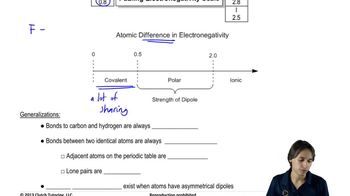Which of the following molecules would you expect to have a dipole moment of zero?
a. CH3CH3
b. H2C═O
c. CH2Cl2
 Verified step by step guidance
Verified step by step guidance Verified video answer for a similar problem:
Verified video answer for a similar problem:



 11:33m
11:33mMaster Differences between ionic, polar and covalent bonds with a bite sized video explanation from Johnny
Start learning